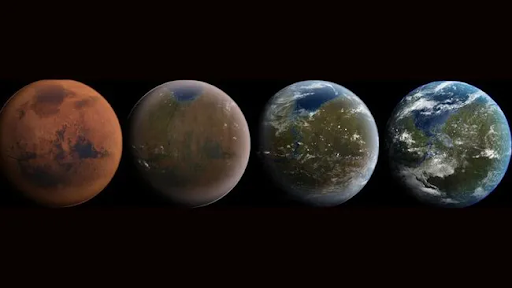Here's a breakdown of the current scientific perspective:
The Goal of Terraforming Mars:
The ultimate aim is to create an environment on Mars where humans could live without extensive life support, and where terrestrial life could thrive. This would involve:
- Raising the temperature: Mars is currently extremely cold, with an average temperature of -63°C (-85°F).
- Thickening the atmosphere: Mars' atmosphere is incredibly thin, less than 1% of Earth's, and primarily composed of carbon dioxide, making it unbreathable. A thicker atmosphere would also help trap heat and provide pressure.
- Introducing liquid water: While Mars has significant water ice reserves, a warmer and denser atmosphere would allow for stable liquid water on the surface.
- Producing oxygen: To make the atmosphere breathable, oxygen would need to be generated in substantial quantities.
- Protecting from radiation: Mars lacks a global magnetic field, leaving its surface exposed to harmful solar and cosmic radiation.
Key Challenges and Limitations:
Despite renewed interest, significant hurdles remain:
- Insufficient accessible CO2: A major barrier is the lack of easily accessible carbon dioxide on Mars to create a thick, warm atmosphere. Most CO2 is locked in forms that are not easily mobilized. Even if all known reserves were released, it might not be enough to significantly increase atmospheric pressure or temperature for human habitability.
- Atmospheric loss: Mars lacks a strong global magnetic field, which means any newly created atmosphere would be vulnerable to being stripped away by solar wind over time, just as its original atmosphere was lost. Addressing this would require massive, unproven engineering solutions, such as creating an artificial magnetosphere.
- Low gravity: Mars' surface gravity is only about 38% of Earth's. The long-term effects of this on human health are still being studied, and it also makes retaining an atmosphere more difficult.
- Toxic soil: Martian soil contains perchlorates, which are toxic to humans.
- Time scale and cost: Full terraforming would likely take centuries or even millennia, and the cost would be astronomical.
Recent Advancements and Proposed Solutions:
Scientists are exploring new approaches and technologies that could make terraforming more plausible, at least in its initial stages:
Engineered microbes (Biological Terraforming): Using extremophilic organisms or genetically engineered microbes (like algae or cyanobacteria) to produce oxygen through photosynthesis and sequester CO2. This is seen as a slow but potentially crucial first step.
Warming methods:
Engineered dust nanoparticles: A groundbreaking proposal involves releasing engineered dust particles (nanorods made from Martian iron and aluminum) into the atmosphere. These particles could be designed to trap heat and scatter sunlight back to the surface, potentially warming the planet by over 30°C (50°F) within decades, making it suitable for microbial life and potentially growing crops. This method is considered far more efficient and feasible than previous ideas as it uses in-situ resources.
- Solar mirrors and aerosols: While previously considered, new research is re-evaluating the efficiency of large solar mirrors or engineered aerosols for warming the planet.
- Advanced habitats: While not planetary-scale terraforming, advancements in 3D/4D-printed shelters and other contained environments could provide localized habitable zones and offer a stepping stone for longer-term presence.
- Improved climate modeling and engineering techniques: Better models allow for more accurate predictions of how the Martian environment might respond to interventions.
- Increased launch capabilities: Technologies like SpaceX's Starship could make the logistical challenge of transporting materials to Mars more manageable.
Ethical Considerations:
The discussion around terraforming also brings up important ethical questions:
- Planetary protection and potential Martian life: The possibility of contaminating or destroying indigenous Martian microbial life (even ancient, fossilized forms) is a significant concern. Scientists emphasize the need for thorough study and sample returns before irreversible changes are made.
- Resource allocation: Should humanity focus resources on terraforming another planet when there are pressing environmental issues on Earth?
Who decides? The implications of transforming another world raise questions about international governance and who has the right to make such profound changes.
Conclusion:
While full terraforming of Mars to a state where humans can breathe outside without assistance remains a distant and highly challenging goal, recent scientific developments suggest that initial steps toward making the planet more hospitable, particularly for microbial life and eventually for more complex life forms within protected environments, are becoming more scientifically grounded. Scientists are calling for serious research into the fundamental physical, chemical, and biological constraints and possibilities of terraforming, recognizing that such an endeavor could not only open up new frontiers but also provide valuable insights for planetary sustainability on Earth.

